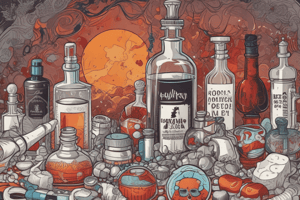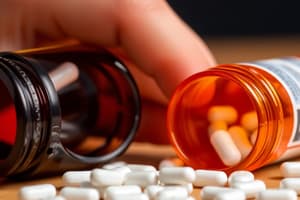Podcast
Questions and Answers
What is a significant characteristic of breakthrough pain?
What is a significant characteristic of breakthrough pain?
- It typically results from emotional distress.
- It usually lasts for an extended period.
- It is only experienced by patients without chronic pain.
- It occurs suddenly in patients with chronic pain conditions. (correct)
What is indicated by the development of drug tolerance in opioid users?
What is indicated by the development of drug tolerance in opioid users?
- They will not need to take the drug anymore.
- They will require higher doses to achieve the same effect. (correct)
- They will experience fewer side effects over time.
- They can continue taking the same dose indefinitely.
Which symptom is typically associated with opioid withdrawal?
Which symptom is typically associated with opioid withdrawal?
- Severe headaches
- Increased energy levels
- Cold flashes with goose bumps (correct)
- Euphoria
What often peaks between 24 to 48 hours after the last dose of an opioid?
What often peaks between 24 to 48 hours after the last dose of an opioid?
How can addiction to opioids affect individuals and society?
How can addiction to opioids affect individuals and society?
What is the primary purpose of substitution therapy for patients addicted to diamorphine?
What is the primary purpose of substitution therapy for patients addicted to diamorphine?
Which two drugs are most commonly used for substitution therapy?
Which two drugs are most commonly used for substitution therapy?
How is substitution therapy typically administered to patients?
How is substitution therapy typically administered to patients?
What effect does taking a prescribed heroin substitute orally have compared to injecting street diamorphine?
What effect does taking a prescribed heroin substitute orally have compared to injecting street diamorphine?
What is the rationale behind prescribing heroin substitutes instead of allowing the purchase of street diamorphine?
What is the rationale behind prescribing heroin substitutes instead of allowing the purchase of street diamorphine?
Flashcards are hidden until you start studying
Study Notes
Drug Addiction Treatment Approaches
- Approaches vary between imprisonment, promoting cessation of illicit substance use, and harm reduction.
- Substitution therapy is commonly used for treating diamorphine (heroin) addiction, involving the prescription of alternative medications.
- Substitution therapy helps patients avoid withdrawal symptoms by replacing illicit drugs with prescribed substitutes that do not provide the same high.
Rationale for Substitution Therapy
- Primary goals include:
- Overall cessation of diamorphine and substitute use.
- Reduction of drug addiction-related harm.
- Prescribed substitutes administered orally are less harmful compared to street diamorphine.
Common Substitution Drugs
- Buprenorphine and methadone are the two main drugs used in substitution therapy.
- Prescriptions are often dispensed in instalments to promote safety and prevent illegal sales.
Harm Minimisation
- Some regions provide pharmaceutical-grade heroin and safe injection facilities as an innovative harm minimisation method.
- This approach is relatively new in the UK but widely adopted in other countries.
Legislative Background
- The laws governing controlled drugs derive from international treaties and inquiries, notably those related to Harold Shipman’s case.
Drug Tolerance and Habitual Use
- Repeated use of opioids can lead to tolerance, necessitating higher doses for the same effect.
- Tolerance shifts the dose-response curve, allowing for increased safety in legitimate medical use for pain management.
Withdrawal Symptoms
- When an individual stops using opioids, they may experience withdrawal symptoms such as muscle pain, insomnia, cold flashes, and gastrointestinal issues.
- Acute withdrawal symptoms typically peak within 24-48 hours and subside after about a week.
Collaborative Intelligence Networks
- The Health Act 2006 mandates collaboration among healthcare and law enforcement to address controlled drug issues.
- Local networks aim to share intelligence regarding concerns about controlled drugs.
Inspections and Regulations
- The Health Act 2006 grants police and designated personnel the authority to inspect premises and relevant records during reasonable hours.
Instalment Dispensing
- Controlled drugs in Schedules 2 and 3 can be prescribed in instalments, particularly for methadone and buprenorphine in substitution therapy.
- New patients generally start with daily collection of prescribed medicine before transitioning to less frequent intervals.
Instalment Direction Requirements
- An instalment direction must specify:
- The amount of medicine supplied per instalment.
- The time interval between each supply.
- Special NHS prescription forms (FP10 MDA) facilitate instalment prescribing in England.
Studying That Suits You
Use AI to generate personalized quizzes and flashcards to suit your learning preferences.




